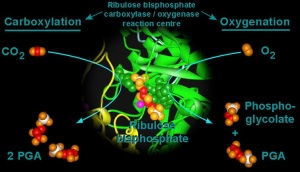Photorespiration 1
Photorespiration (also known as the oxidative photosynthetic carbon cycle, or C2 photosynthesis) is a process in plant metabolism which attempts to reduce the consequences of a wasteful oxygenation reaction by the enzyme RuBisCO. The desired reaction is the addition of carbon dioxide to RuBP (carboxylation), a key step in the Calvin–Benson cycle, however approximately 25% of reactions by RuBisCO instead add oxygen to RuBP (oxygenation), producing a product that cannot be used within the Calvin–Benson cycle. This process reduces efficiency of photosynthesis, potentially reducing photosynthetic output by 25% in C3 plants.[1] Photorespiration involves a complex network of enzyme reactions that exchange metabolites between chloroplasts, leaf peroxisomesand mitochondria.
The oxygenation reaction of RuBisCO is a wasteful process because 3-Phosphoglycerate is created at a reduced rate and higher metabolic cost compared with RuBP carboxylase activity. While photorespiratory carbon cycling results in the formation of G3P eventually, there is still a net loss of carbon (around 25% of carbon fixed by photosynthesis is re-released as CO2)[2] and nitrogen, asammonia. Ammonia must be detoxified at a substantial cost to the cell. Photorespiration also incurs a direct cost of one ATP and one NAD(P)H.
http://ww2.methuen.k12.ma.us/mnmelan/understanding_cellular_respirati.htm

Schematic representation of the photorespiratory pathway (in black) and the three circumvent pathways designed to overcome the photorespiratory losses. 1 The reactions of bypass 1 (in red) are entirely realized into the chloroplast and comprise the transformation of glycolate to glycerate, introducing glycolate dehydrogenase, glycine decarboxylase and tartronate semialdehyde reductase similar to the E. coli glycolate catabolic pathway (Kebeish et al., 2007). Bypass 2 (in green) follows the E. coli glyoxylate catabolic pathway in the peroxisomes by introducing glycine decarboxylase and hydroxypyruvate isomerase (Carvalho et al., 2011). Bypass 3 (in blue) oxidizes glycolate to CO2 in the chloroplast, using exogenous (glycolate oxidase and catalase from the peroxisomes, and malate synthase from the glyoxysomes) and endogenous (malic enzyme and pyruvate dehydrogenase) enzymes (Maier et al., 2012). In all three bypasses release of ammonia in the mitochondrion is abolished; 75% of the glycolate redirected toward bypasses 1 and 2 is returned to the Calvin-Benson cycle as 3-PGA; bypasses 1 and 3 dislocate CO2 released from the mitochondrion to the chloroplast. Reactions stoichiometry is not taken into account; the numbers of carbon atoms of each metabolic compound are in italic; 3-PGA, 3-phosphoglycerate; RuBP, ribulose 1,5-bisphosphate.
1) http://www.ncbi.nlm.nih.gov/pmc/articles/PMC4054791/
Photorespiration (also known as the oxidative photosynthetic carbon cycle, or C2 photosynthesis) is a process in plant metabolism which attempts to reduce the consequences of a wasteful oxygenation reaction by the enzyme RuBisCO. The desired reaction is the addition of carbon dioxide to RuBP (carboxylation), a key step in the Calvin–Benson cycle, however approximately 25% of reactions by RuBisCO instead add oxygen to RuBP (oxygenation), producing a product that cannot be used within the Calvin–Benson cycle. This process reduces efficiency of photosynthesis, potentially reducing photosynthetic output by 25% in C3 plants.[1] Photorespiration involves a complex network of enzyme reactions that exchange metabolites between chloroplasts, leaf peroxisomesand mitochondria.
The oxygenation reaction of RuBisCO is a wasteful process because 3-Phosphoglycerate is created at a reduced rate and higher metabolic cost compared with RuBP carboxylase activity. While photorespiratory carbon cycling results in the formation of G3P eventually, there is still a net loss of carbon (around 25% of carbon fixed by photosynthesis is re-released as CO2)[2] and nitrogen, asammonia. Ammonia must be detoxified at a substantial cost to the cell. Photorespiration also incurs a direct cost of one ATP and one NAD(P)H.
http://ww2.methuen.k12.ma.us/mnmelan/understanding_cellular_respirati.htm

Schematic representation of the photorespiratory pathway (in black) and the three circumvent pathways designed to overcome the photorespiratory losses. 1 The reactions of bypass 1 (in red) are entirely realized into the chloroplast and comprise the transformation of glycolate to glycerate, introducing glycolate dehydrogenase, glycine decarboxylase and tartronate semialdehyde reductase similar to the E. coli glycolate catabolic pathway (Kebeish et al., 2007). Bypass 2 (in green) follows the E. coli glyoxylate catabolic pathway in the peroxisomes by introducing glycine decarboxylase and hydroxypyruvate isomerase (Carvalho et al., 2011). Bypass 3 (in blue) oxidizes glycolate to CO2 in the chloroplast, using exogenous (glycolate oxidase and catalase from the peroxisomes, and malate synthase from the glyoxysomes) and endogenous (malic enzyme and pyruvate dehydrogenase) enzymes (Maier et al., 2012). In all three bypasses release of ammonia in the mitochondrion is abolished; 75% of the glycolate redirected toward bypasses 1 and 2 is returned to the Calvin-Benson cycle as 3-PGA; bypasses 1 and 3 dislocate CO2 released from the mitochondrion to the chloroplast. Reactions stoichiometry is not taken into account; the numbers of carbon atoms of each metabolic compound are in italic; 3-PGA, 3-phosphoglycerate; RuBP, ribulose 1,5-bisphosphate.
1) http://www.ncbi.nlm.nih.gov/pmc/articles/PMC4054791/




